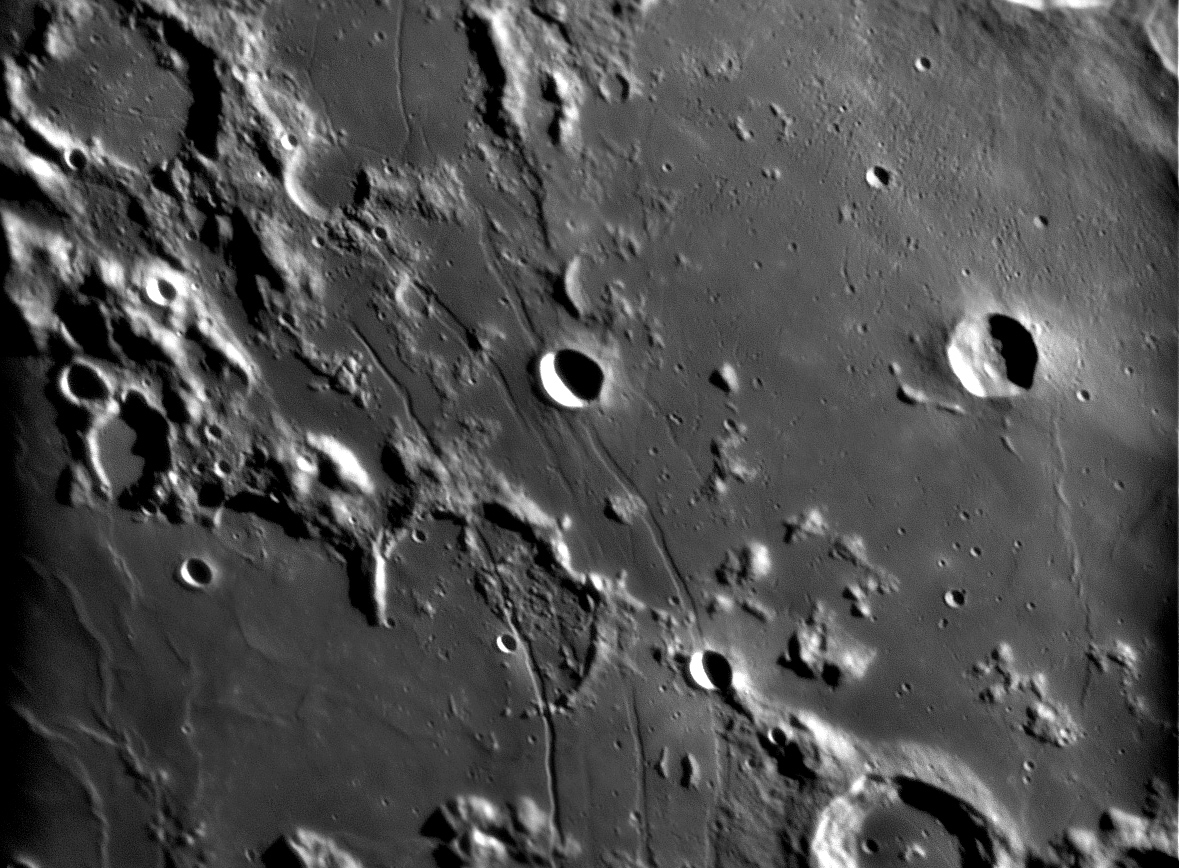|
|
| (7 intermediate revisions by the same user not shown) |
| Line 1: |
Line 1: |
| | __NOTOC__ | | __NOTOC__ |
| | =Hip, Hip, Hooray for Hippalus= | | =Hip, Hip, Hooray for Hippalus= |
| | + | <!-- Start of content --> |
| | <div class="post" id="post-237"> | | <div class="post" id="post-237"> |
| | | | |
| | <div class="storycontent"> | | <div class="storycontent"> |
| | <p>[[File:Rima_Hippalus_A_1_04_08_06_S475_AP2.jpg|Hippalus rille-wes]]Image by [mailto:starman2@charter.net Wes Higgins]</p> | | <p>[[File:Rima_Hippalus_A_1_04_08_06_S475_AP2.jpg|Hippalus rille-wes]]Image by [mailto:starman2@charter.net Wes Higgins]</p> |
| − | <p>The standard of excellence for the Hippalus Rilles east of Mare Humorum is the now classic Stephen Keene [[January_26,_2004|image]] showing the area under grazing illumination. That is still the benchmark for low Sun imaging, but Wes’ recent view of the rilles achieves a new standard for higher angles of illumination. There are many stories to decipher from this image. At top right are closely aligned secondary craters from Bullialdus (just out of the image). These are not long secondary crater chains as seen at [http://www.lpod.org/?m=20060419 Aristillus] but they are chain-like, and their distribution stops pretty abruptly. Individual small clusters of secondaries occur further from Bullialdus (entire right half of image). The three large Hippalus rilles are crisply deliniated, marking the bend where Humorum lavas tilt toward the basin center. To the north, within and near the crater Agatharchides, are delicate rilles known from Lunar Orbiter IV [http://www.lpi.usra.edu/resources/lunar_orbiter/images/img/iv_132_h1.jpg images] but rarely seen from Earth. These rilles are narrower and shallower than the Hippalus rilles and not obviously related to sagging of the Humorum basin. A thorough study of the tectonics of this area is needed!</p> | + | <p>The standard of excellence for the Hippalus Rilles east of Mare Humorum is the now classic Stephen Keene [[January_26,_2004|image]] showing the area under grazing illumination. That is still the benchmark for low Sun imaging, but Wes’ recent view of the rilles achieves a new standard for higher angles of illumination. There are many stories to decipher from this image. At top right are closely aligned secondary craters from Bullialdus (just out of the image). These are not long secondary crater chains as seen at [[April_19,_2006|Aristillus]] but they are chain-like, and their distribution stops pretty abruptly. Individual small clusters of secondaries occur further from Bullialdus (entire right half of image). The three large Hippalus rilles are crisply deliniated, marking the bend where Humorum lavas tilt toward the basin center. To the north, within and near the crater Agatharchides, are delicate rilles known from Lunar Orbiter IV [http://www.lpi.usra.edu/resources/lunar_orbiter/images/img/iv_132_h1.jpg images] but rarely seen from Earth. These rilles are narrower and shallower than the Hippalus rilles and not obviously related to sagging of the Humorum basin. A thorough study of the tectonics of this area is needed!</p> |
| | <p>[mailto:tychocrater@yahoo.com Chuck Wood]</p> | | <p>[mailto:tychocrater@yahoo.com Chuck Wood]</p> |
| | <p><b>Technical Details:</b><br /> | | <p><b>Technical Details:</b><br /> |
| Line 12: |
Line 13: |
| | Rükl plates 52 & 53<br /> | | Rükl plates 52 & 53<br /> |
| | [http://higginsandsons.com/astro/ Wes’ website]</p> | | [http://higginsandsons.com/astro/ Wes’ website]</p> |
| − | <p align="center"><b>SUPPORT LPOD - VISIT A SPONSOR (CLICK AN AD BELOW)! </b><br /> | + | <p><b>Yesterday's LPOD:</b> [[April 20, 2006|ISS Over the Moon]] </p> |
| − | <i>Now you can support LPOD when you buy ANY book from Amazon thru [http://www.lpod.org/?page_id=102 LPOD!]</i></p> | + | <p><b>Tomorrow's LPOD:</b> [[April 22, 2006|Crater Chains and Unknown Rille]] </p> |
| | </div> | | </div> |
| − | ----
| + | <p> </p> |
| − | ===COMMENTS?===
| + | <p> </p> |
| − | Register, and click on the <b>Discussion</b> tab at the top of the page.
| + | <p> </p> |
| | + | <!-- End of content --> |
| | + | {{wiki/ArticleFooter}} |
 Image by Wes Higgins
Image by Wes Higgins


